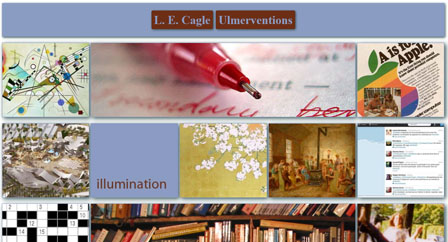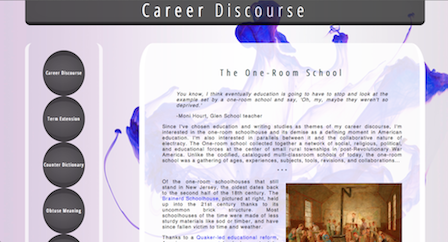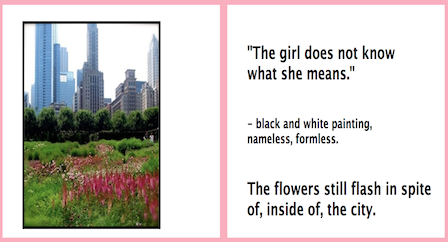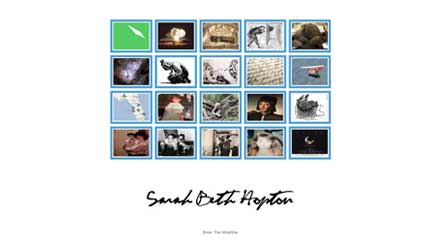Our [Electrate] Stories
Explicating Ulmer's Mystory Genre
Marc C. Santos, Ella R. Bieze, Lauren E. Cagle, Jason C., Zachary P. Dixon, Kristen N. Gay, Sarah Beth Hopton, Megan M. McIntyre
Recommendations: Marc C. Santos
1. What work does a mystory do?
I want to begin by highlighting three particular responses. Kristen N. Gay stressed how the mystory isn’t about “knowing ourselves” as much as becoming aware of our boundaries. Lauren E. Cagle noted, “the mystory illustrates for us the complex network of relations and influences, many half-forgotten or undervalued, that shape us.” By attuning ourselves to what supports us, our constitutive networks, we are better prepared to welcome others and accept their differences. Megan M. McIntyre gets at this when she frames the mystory as a project of self-discovery without SELF-discovery, what we might specify as a kind of self-exploration, a personal dérive without either definitive aim or findings.
Cagle noted how sharing and discussing with her classmates the emotional content unearthed through the mystory process revealed to her “another way of being that literacy has not prepared us for: being a listener, not a creator; an emotional respondent, not a critiquer.” Besides serving as another endorsement for the connection between Gregory L. Ulmer’s electric pedagogy and Krista Ratcliffe’s (2006) project of rhetorical listening, this conclusion also stresses a postpedagogic dimension of the mystory: the way in which it promotes non-critical exploration and response without insisting upon the kind of explicit, critical orientation that often marks cultural study. I think these ethical dimensions are precisely the promise of Ulmer’s socio-expressivist pedagogy.
As our reading of Ulmer via James Berlin suggests, those looking for the kind of critical certainty promised by socio-epistemic pedagogy might find the mystory too laissez-faire in its approach. However, those who favor indirect, cunning and/or postpedagogical approaches to cultural critique will likely follow Thomas Rickert and recognize the value in Ulmer’s subtly subversive, seemingly expressivist, project. Cagle characterized the work of the mystory as largely “unconscious.” In her response to the question of whether the mystory should be public or private, McIntyre wonders whether it actually matters, since, in classic “don’t think of an elephant” (Lakoff, 2004) style, the mystory triggers affective responses even for material a student chooses not to write about. Ella R. Bieze and Sarah Beth Hopton both couch their aha experience in spectral terms, framing it as an encounter with what haunts them.
2. Did you experience an aha moment?
All of the students in the project reported having some kind of aha experience with the mystory. As the responses to question 1 revealed, many of these moments resonate with psychoanalytic theory. Much more than the undergraduates with whom I have done the mystory, graduate students in my course remarked upon the psychoanalytic/therapeutic dimensions of the project. Gay, Jason C., Cagle, and Zachary P. Dixon all explicitly call attention to the importance of Ulmer’s interest in the punctum, what Roland Barthes identifies as the sting of personal memory that interrupts the studium, or general cultural memory.
Gay went as far as to claim that the mystory “works to break us,” to which she steadfastly responded that “Ulmer cannot fix me.” To be fair, I do not believe Ulmer is trying to fix anyone (and nor does Gay), especially because I do not believe his poststructuralist, postmodern, and psychoanalytic theoretical investments do not allow for a conception of the one, true, right, subject. If Ulmer is trying to break anything, it is the Humanist fetishization of the coherent autonomous Modern subject (or, perhaps better said, he is trying to reveal that such a prospective subject was always, already broken apart and spread across cultural, institutional, and material networks). But as these student anecdotes, and as anyone who has taught socio-epistemic rhetoric or cultural studies can attest, student trauma and resistance are a natural byproduct of these pedagogical orientations. That Ulmer does not directly challenge student ideology or subjectivity, but rather establishes conditions for those students to issue such challenges themselves, mitigates, but does not dissipate, this trauma.
As I elaborate on further in my response to question 5 below, I would advise instructors to be prepared for these kinds of deep, emotional responses. Not every student will dig as deep as Gay or Hopton, but all will likely encounter something unheimlich that disequilibriates them. I would echo McIntyre and remind potential instructors that the punctum's sting, like all stings, can hurt. Probing memories can be a difficult and painful process—even if, as these responses testify, it can be a productive one. An instructor contemplating teaching the mystory needs to establish a safe space for such exploration and be prepared to encounter students encountering/working through emotional material. Ratcliffe’s (2006) attunement to rhetorical listening provides a solid foundation for constructing such an environment. There is clearly fertile ground here for more scholarship exploring the overlaps between feminist rhetoric and pedagogy and Ulmer’s mystory.
3. Does the mystory realize Ulmer’s aspirations?
The student responses to this query contain two interrelated threads evaluating two different dimensions of the mystory. First, the responses address the extent to which the mystory engendered personal and/or social transformations; much of this ground has been covered in the responses to questions 1 and 2. Second, they address Ulmer’s attempt to invent new forms of composition in light of digital/new media affordances.
Gay and McIntyre enthusiastically approve of Ulmer’s project. However, both are predisposed to Ulmer’s theoretical aspirations. Gay is working toward a dissertation project that extends Ulmer’s electrate pedagogy to more explicitly therapeutic environments. McIntyre’s dissertation project evaluates postpedagogy’s potential to reframe student agency as dependent and networked and technology as lively and agentive in the writing classroom. Thus, both students entered the course not only familiar, but also invested, in Ulmer’s project: they both were determined to make it work well and to give it their full attention.
Cagle, Dixon, and Hopton—three students with no previous allegiance to Ulmer’s work—consistently wavered on this answer. All three agree that the mystory has profound potential for personal change. But all three, in different ways, wish the mystory had more direct social/political consequences. In other words, they do not question whether the mystory has the potential to change the self, but they do wonder whether it has potential to take the next step and live up to Ulmer’s aspirations to change the world. Hopton puts this most succinctly when she recognizes that the mystory is about (intrapersonal) process, not necessarily about (publicly shareable) product. These students’ concerns regarding the political efficacy of the mystory should not be dismissed; in response, I would point back to our conclusion on electracy and stress how the mystory lays the groundwork for cultivating an empathic and responsible civic agent ready to participate in agonistic, democratic politics. No doubt that Ulmer’s book Electronic Monuments (2005) offers a more explicitly social and political project. Also, as a side note, I would advise Electronic Monuments to instructors looking for a shorter, more contained project—while in my experience the mystory can take between 6–8 weeks, an electronic monument can be completed within 3–4 weeks.
In terms of the second issue, whether the mystory helps advance a new mode of writing, the answers were less affirmative. Dixon and Cagle in particular were hesitant on this point, noting how the mystory is still by and large textual and relies on established (literary) narrative forms. I would respond noting how Ulmer frames the shift from literacy to electracy, like the shift from orality to literacy, as a competition and not necessarily a transition. We do not move past literacy. Rather, we come to dwell with elements of literacy (and orality) and electracy—all three epochs competing for our attention values. The categories of Ulmer’s electracy (2009) grid are in competition.[13] Perhaps we need look no further than the contemporary ideological struggles between church, state, and now Internet (Ulmer’s institutional apparatus for orality, literacy, and electracy) to recognize such tension.[14] Furthermore, while there is still a heavily textual bias to the mystory, it produces texts with quite different purposes than the traditional texts (academic, objective, authoritarian, critical) we might associate with literacy (at least Walter J. Ong’s (1986) notion of it).
4. Can/should you learn Ulmer while learning HTML and CSS?
Given the levels of frustration and exhaustion voiced and witnessed throughout the semester, I was surprised to see how many of these responses supported learning HTML and CSS alongside Ulmer’s mystory. While I would never question the conscious integrity of graduate students in my courses, I do have to wonder if their enthusiastic responses do not exhibit at least a tiny amount of participant bias, a bending of their answers to the anticipated desire of the researcher. I would like to think—as many of them write—that the creative impulse inherent in the mystory is amplified by the frustration/exhiliration of working in a new medium. Gay offers a particularly compelling response, arguing that coding gave her a measure of control over the chaotic and risky stings of the mystory.
While I, concluding a research manuscript on the mystory, should probably have a definitive answer to this question, I’ll admit that I remain torn. One the one hand, the increasing sophistication of content management systems and web publishing programs (such as Joomla, Drupal, or WordPress) might make obsolete the intense laboriousness of learning HTML and CSS (one can learn the fundamentals of HTML in a week, but, as those of us who have fought through know, learning CSS takes significantly longer). Thus my hesitancy has less to do with learning HTML and CSS alongside Ulmer as it has to do with learning it at all. Should graduate students, already overburdened with acclimating to the many discourses in rhetoric and composition, be encouraged to take on yet another, specifically new one that can swallow entire blocks of time as they try to determine why that little bit of padding between their header and their navigation divisions won’t go away (hint: make sure you set the padding bottom on your H1 tag to zero)?
Yet, on the other hand, if we are serious about Ulmer’s electrate challenge to invent new forms of and aesthetics for composing, then we must have access to the core languages that can fuel experimentation and innovation. We must continue to shape new mediums, not just the messages composed within prefab media. In doing so, however, we must be careful to avoid overly reductive treatments of content management systems that position them as an always, already inferior option; they, too, have grown in sophistication. It is likely that any scholar hoping to specialize in new/social/digital media will likely need to familiarize herself with both.
Ultimately, I belabor this point to stress upon potential instructors the need to prioritize pedagogical goals. Teaching code? Or personal introspection? The conviction with which you answer this question will likely determine whether you choose to employ a content management system (CMS) or teach code from the ground up.
5. Should a mystory be public or private?
To be frank, I was not prepared for the levels of emotional intensity the mystory triggered. My previous experiences with the mystory had been with undergraduates; few ever reported anything close to the cathartic forcefulness of the students coauthoring this article. My lack of preparation was nowhere as evident as it was with the decision as to whether a mystory should be public or private. My own ideological investments in Web 2.0 techophilosophy coupled with my own experiences theorizing and publishing deeply personal experiences blinded me to the violence of forcing students to post their mystories to the web (Santos, 2011).[15]
Bieze rightly suggested leaving the decision up to the author:
there’s a certain violence in forcing someone to share publicly what they would rather keep private, and because of that I’m not willing to say whether the mystory should be public or private, only that it could be either, and it is up to the person creating it to decide which is right for him or her.
McIntyre notes that the public nature of the mystory forced some consciously rhetorical self-censorship:
If I'm the one in charge of how the stories of my childhood [are represented], particularly in my Family and Community Discourses, where other people are the main focus of my discussions, I'm also the one who must constantly question how I've represented those others. . . . My relationship to these others is vital to understanding how I came to be as I am, but I constantly struggled with the ethics of my representations of those relationships.
Asking students to put their mystory online could force many students to stray away from truly transformational exploration out of the fear of exposing themselves.
Dixon complicates this entire line of questioning:
While a mystory might not be interactive on an obvious level (no call and response is built into the project), I think that fundamentally, by placing your work online, you are engaging in a form of interactivity, even if it is just with yourself.
Gay argued that the only real audience for a mystory is oneself; this recalls Ulmer’s statement the best response to a mystory is to compose one for oneself.
Cagle suggests that allowing students to contemplate and discuss whether to share their mystories online triggers a line of productive questioning concerning the expectations for a professional ethos and public discourse. I believe the most ethical response to this question, one in line with my postpedagogical orientation, is to leave students with the choice of whether to post their work to the Internet or keep it offline. Postpedagogical theory stresses how an instructor cannot attempt to force personal or cultural transformation. We can only try to establish conditions commensurate to such transformation. By providing students the option of whether to share their work or submit it offline, I allow them to articulate conditions in which they feel comfortable. That, I believe, is essential to teaching them how to listen for their own ghosts[16].
6. What else do you want to say?
I conclude not by merely stressing what I consider the productive dimensions of the mystory, but rather by highlighting the immense institutional, political, and cultural challenges enacting such a postpedagogy might require. As an instructor who has experimented with the mystory at both the graduate and undergraduate level, I offer this as a closing thought: Ulmer’s postpedagogical appreciation of risk recalls Cicero’s (1986) advice to the parents of Rome:
Let us, then, cease to wonder what is the cause of the scarcity of good speakers, since eloquence results from all those qualifications, in each of which singly it is a great merit to labor successfully; and let us rather exhort our children, and others whose glory and honor is dear to us, to contemplate in their minds the full magnitude of the object [oratory], and not to trust that they can reach the height at which they aim, by the aid of precepts, masters, and exercises, that they are all now following, but to understand that they must adopt others of a different character. (pp. 10-11)
Just as Cicero lived through the transformation of an oral political sphere into a literate one, so, too, are we living through a similar institutional transformation: the transformation of education from a literate institution to an electrate one. As the institution of literacy responds to the electrate challenge by envisioning an educational world increasingly colonized by new masters under the banners of standardization, accountability, and assessment, Ulmer’s mystory institutes a different character avatar for writing instruction that would forward the idiosyncratic, the affective, and the networked constitution of the electrate self. Such a process might sting a bit.





